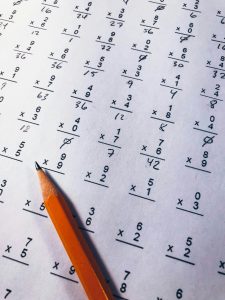Math Puzzles for Different Learning Styles: Visual, Auditory, and Kinesthetic

Introduction
Are you a parent who is concerned about your child’s struggle with mathematics? Do you want to find effective ways to help your child grasp mathematical concepts easily? Math puzzles can be the answer you’ve been searching for. By tailoring math puzzles to different learning styles, you can engage your child in a way that resonates with them and facilitates their understanding of mathematical concepts. In this article, we will explore the three main learning styles – visual, auditory, and kinesthetic – and provide you with a range of math puzzle ideas for each style. With these learning activities, your child can embark on a hands-on learning process that will unlock their potential in mathematics.
Visual Learners
Visual learners have a strong preference for images, diagrams, and spatial relationships. They grasp concepts best when they can see them visually. To engage visual learners in math puzzles, incorporate visual elements and patterns into the activities.
Picture Puzzles: These puzzles use images, shapes, or diagrams to represent mathematical problems. Tangram challenges or puzzles, where students identify patterns in pictures, are great examples. Visual learners will enjoy the visual representation of the problems.
Sequence and Pattern Puzzles: Activities that require finding the next shape or number in a visual sequence are perfect for visual learners. These puzzles help them recognize and predict patterns by relying on their visual skills.
Math Crosswords: Crosswords where numbers or equations fill the grid allow visual learners to see the relationships between clues visually. The visual nature of crosswords aids in their understanding of mathematical concepts.
Sudoku and Magic Squares: Grids that require filling in numbers based on visual logic and spatial rules are excellent for visual learners. They support pattern recognition and logical thinking, which are key skills for solving math problems.
Auditory Learners
Auditory learners thrive when they can listen, speak, and discuss problems. They benefit from verbal instructions and enjoy solving puzzles through discussions or storytelling. Here are some math puzzle ideas for auditory learners:
Math Riddles and Word Problems: Puzzles presented as stories or riddles that students can listen to, discuss, and solve aloud are perfect for auditory learners. These puzzles encourage reasoning, verbal problem-solving, and critical thinking skills. Engage your child in lively discussions about the problem-solving process to deepen their understanding.
Collaborative Brain Teasers: Group puzzles where students talk through their reasoning provide an excellent platform for auditory learners to engage with mathematical concepts. Logic riddles or complex problems that require shared strategies can stimulate their thinking process.
Math Songs or Rhymes: Incorporating math facts or patterns into songs or chants can reinforce concepts in a memorable, auditory way. By turning mathematical concepts into catchy tunes, you can help auditory learners remember key information more effectively.
Explaining Solutions: Encourage your child to explain their reasoning and solutions out loud, either to peers or adults. This verbalization reinforces understanding and clarity of thought while enhancing their ability to communicate mathematical ideas effectively.
Kinesthetic Learners
Kinesthetic learners understand best through movement, touch, and hands-on activities. To engage kinesthetic learners in math puzzles, involve physical manipulation or real-world scenarios.
Shape and Manipulative Puzzles: Using physical objects like blocks, tangrams, or dominoes to solve puzzles allows kinesthetic learners to build, move, and experiment with solutions. These hands-on experiences enhance their understanding of mathematical concepts.
Math Board Games: Games that require players to move pieces, count spaces, or physically interact with the board engage the kinesthetic learning style. These games provide an interactive and enjoyable way for kinesthetic learners to solve math challenges.
Role-Playing or Real-Life Scenarios: Puzzles that simulate real-world activities, such as acting out shopping scenarios, making change, or solving problems with props, cater to kinesthetic learners’ desire for practical application of math concepts.
Interactive Problem Solving: Activities like scavenger hunts for math clues or assembling puzzles on large surfaces encourage movement and engagement. Kinesthetic learners thrive in environments where they can physically interact with the material.
Table: Math Puzzles for Different Learning Styles
|
Learning Style |
Puzzle Types & Activities |
How They Help Learners |
|---|---|---|
|
Visual |
Sudoku, Magic Squares, Pattern/Sequence Puzzles, Geometric Puzzles, Input/Output Tables |
Use images, grids, and patterns to help students recognize relationships, understand rules, and develop spatial reasoning. |
|
Auditory |
Math Riddles, Word Problems, Collaborative Brain Teasers, Verbal Explanations |
Involve listening, discussing, and explaining solutions aloud, which strengthens reasoning, comprehension, and communication skills. |
|
Kinesthetic |
Manipulative Puzzles (Tangrams, Blocks), Math Board Games, Real-Life Scenarios (Shopping, Measuring), Interactive Games |
Engage learners through hands-on activities and movement, making abstract concepts concrete and enhancing memory through physical experience. |
This table highlights how different types of math puzzles can be matched to visual, auditory, and kinesthetic learning styles, ensuring every child can engage with math in a way that suits them best
Summing Up
In conclusion, math puzzles tailored to different learning styles can significantly enhance your child’s mathematical abilities. By understanding their preferred learning style – visual, auditory, or kinesthetic – you can engage your child in a hands-on learning process that suits their individual needs. Visual learners benefit from picture puzzles and pattern recognition activities. Auditory learners excel in solving math riddles and participating in collaborative brain teasers. Kinesthetic learners thrive when engaging in hands-on activities and real-world scenarios. Introducing these math puzzles into your child’s learning routine will not only improve their mathematical skills but also foster a love for problem-solving and critical thinking.
As you embark on this journey with your child, consider enrolling them in SIP Abacus programs, which offer world-class skill development programs focused on developing mental math abilities and overall intelligence. SIP Abacus uses the abacus tool and visualization techniques to teach children mental math skills from ages 6-12. Their structured levels and proven track record ensure effective learning experiences for your child. With SIP Abacus, your child will develop strong mental math abilities, improve concentration, enhance overall intelligence, boost confidence, and gain a competitive edge in exams and future competitive tests. Join SIP Abacus to unlock your child’s full potential in mathematics and beyond.



